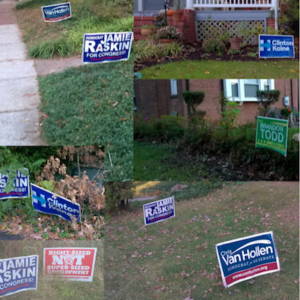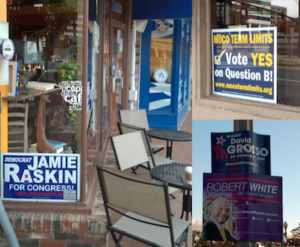By Sarah John, Research Director, FairVote 
In Australia you might get the impression that, for Americans, November 8th will be all about deciding between Donald Trump and Hillary Clinton. But the presidency is not the only office on the ballot this November and, in terms of the everyday lives and passions of Americans, is not necessarily the most important.
If you take a walk around almost any neighbourhood across the country and pay attention to the yard signs (corflutes) out in people’s yards and in shop windows, you’d be hard pressed to know that a presidential election was taking place. In San Francisco, California, for example, you’ll see more signs for the fourteen other officials voters will choose on their 9 page ballot next Tuesday. Even more yard signs will be encouraging citizens to vote “Yes”, “Si”  or “No” on the 17 state ballot questions—ranging from eliminating the death penalty, legalizing marijuana, and banning plastic bags—and 25 local ballot questions. (If these proposals get the support of a majority of voters, they become law and the legislature cannot repeal or amend them.)
or “No” on the 17 state ballot questions—ranging from eliminating the death penalty, legalizing marijuana, and banning plastic bags—and 25 local ballot questions. (If these proposals get the support of a majority of voters, they become law and the legislature cannot repeal or amend them.)
Two of the most important offices American voters will elect are their Representative in the U.S. House and (in two-thirds of states) one of their U.S. Senators. These elections are important because it is Congress—not the President—that passes legislation and writes the government budget. Congress will decide on the passage of the Trans-Pacific Partnership. And it will be the U.S. Senate that confirms (or otherwise) the next U.S. Supreme Court nominee. In short, the partisan makeup of Congress will affect the direction of U.S. policy from health insurance to immigration, gun control and money in politics.
Currently, Republicans have majorities in both houses: 247 to 188 in the U.S. House and 54 to 46 in the U.S. Senate. Over the past few weeks, pundits have been increasingly predicting a Clinton landslide (though these predictions might be tempered now with the recent FBI revelations).
So, does that mean the Democratic Party will capture majorities in both chambers?
Probably not.
The most prestigious and powerful chamber, the Senate, is reasonably likely to be taken back by the Democrats. The seats up for election in 2016 were last filled in 2010, a midterm election (midterms usually favour Republicans) at the height of the Tea Party movement in which dissatisfaction with Obama and Obamacare drove higher Republican turnout. In a normal, more Democratic, presidential year, we’d expect some of the 24 Republican-held seats up for election to fall back to the Democrats, while the 10 Democrat-held seats up for election likely remain Democratic.
In 2016, the electorate’s unprecedented dislike of the two presidential candidates is drawing commentary about the role of third parties and independents in the U.S. Senate. Some wonder if voters’ decision to vote for a third party candidate for president will affect how they vote lower on the ballot. Additionally, on the right of the political spectrum, Libertarian Party and independent conservative candidates threaten to split the vote and make it easier for Democrats to win seats. Politico reports that in New Hampshire, “a third-party conservative is openly running as a spoiler that could hurt the chances” of Republican Senator, Kelly Ayotte, holding her seat. In other states, Libertarian candidates are mounting campaigns that might similarly split the vote, handing the Democrats the seat.
In all likelihood, Democrats will take 3 or 4 U.S. Senate seats from the Republicans, bringing them painfully close to a majority. And, in the case of a 50-50 tie, the Vice-President casts the deciding vote.
While there is much for Democrats to be happy about, it is unlikely they will win the federal trifecta: President, U.S. Senate, and U.S. House.
The U.S. House of Representatives is likely to remain under Republican control. Demographic trends in the United States ensure that most U.S. House seats are safely Republican (in the suburban and rural parts of the country) or safely Democratic (in the inner cities and areas we would call the inner suburbs). There are few swing seats in play. Indeed, as FairVote’s Theo Landsman details, even a Clinton landslide would not deliver Democrats the House. Landsman estimates that the Democrats would need to win the national two-party preference 54.8% to 45.2% in order to reach even a one seat majority in the House. That may not sound like much, but the United States is increasingly split 50 – 50 between the two parties. Landsman notes, at the presidential level, a two-party preference vote of 54.8% would be a landslide that has no precedent in the last half-century.
So, in all likelihood, expect divided government to continue for four more years.

